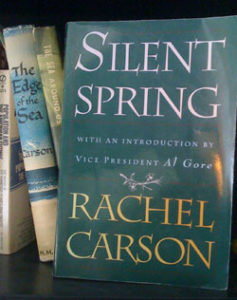 Born in 1907, Rachel Carson grew up on a farm in Pennsylvania and eventually went on to study marine biology, earning her Masters’ degree in the subject from Johns Hopkins University. Carson taught at the University of Maryland for a few years, but eventually went to work at the Department of Interior, during which she wrote books and articles related to the environment. The first three books focused on the sea and did not provoke much attention, but her third book—Silent Spring—became a best seller that changed the way people think about chemicals and the environment.
Born in 1907, Rachel Carson grew up on a farm in Pennsylvania and eventually went on to study marine biology, earning her Masters’ degree in the subject from Johns Hopkins University. Carson taught at the University of Maryland for a few years, but eventually went to work at the Department of Interior, during which she wrote books and articles related to the environment. The first three books focused on the sea and did not provoke much attention, but her third book—Silent Spring—became a best seller that changed the way people think about chemicals and the environment.
Silent Spring began as a series of articles published in the New Yorker magazine. The book’s purpose was to alert the world about the risks associated with pesticides and other chemicals, which Carson feared could cause widespread problems in the environment and harm public health. But rather than offering her concerns in a measured way, Carson painted an extreme view that chemicals were causing—or would cause—cancers and harming wildlife—essentially producing a world in which “no birds sing” and “one in four” people would potentially die from chemically caused cancers.
While many have believed that such strong rhetoric was needed to garner necessary attention to the issue, the book created a culture of fear—which produced extreme anti-chemical policies rather than policies to simply find ways to manage risks. Ironically, some of those policies have contributed much more to public health risks than they have to reducing them. This website documents some of these problems with the hope that better information about Carson’s legacy will reverse misguided public policies and preventing the implementation of new ones.

















